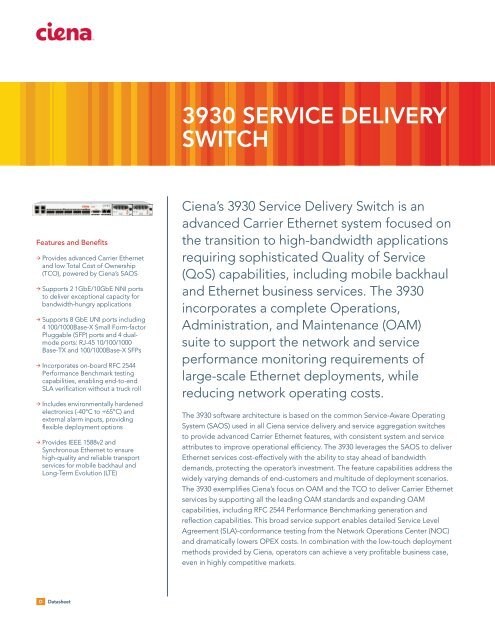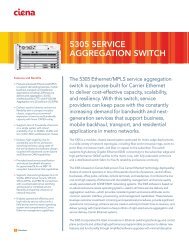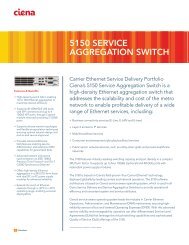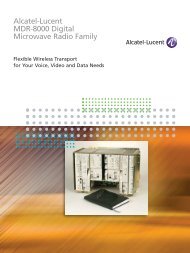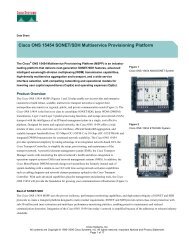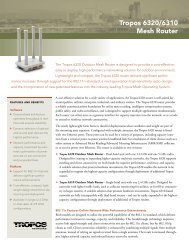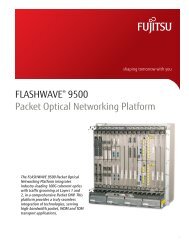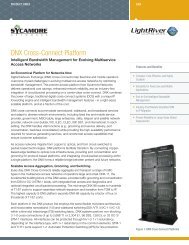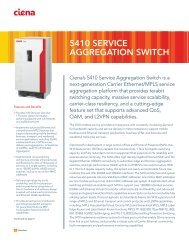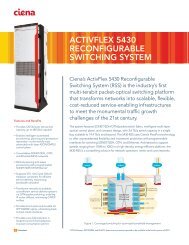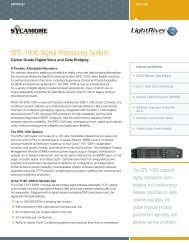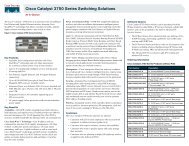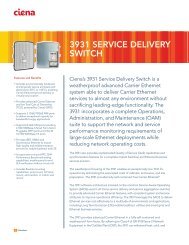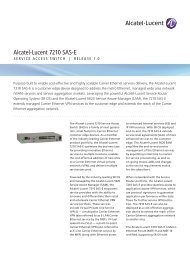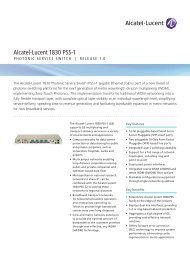Ciena 3930 Brochure - LightRiver Technologies, Inc.
Ciena 3930 Brochure - LightRiver Technologies, Inc.
Ciena 3930 Brochure - LightRiver Technologies, Inc.
- No tags were found...
Create successful ePaper yourself
Turn your PDF publications into a flip-book with our unique Google optimized e-Paper software.
<strong>3930</strong> SERVICE DELIVERYSWITCHFeatures and Benefits> Provides advanced Carrier Ethernetand low Total Cost of Ownership(TCO), powered by <strong>Ciena</strong>’s SAOS> Supports 2 1GbE/10GbE NNI portsto deliver exceptional capacity forbandwidth-hungry applications> Supports 8 GbE UNI ports including4 100/1000Base-X Small Form-factorPluggable (SFP) ports and 4 dualmodeports: RJ-45 10/100/1000Base-TX and 100/1000Base-X SFPs> <strong>Inc</strong>orporates on-board RFC 2544Performance Benchmark testingcapabilities, enabling end-to-endSLA verification without a truck roll> <strong>Inc</strong>ludes environmentally hardenedelectronics (-40°C to +65°C) andexternal alarm inputs, providingflexible deployment options> Provides IEEE 1588v2 andSynchronous Ethernet to ensurehigh-quality and reliable transportservices for mobile backhaul andLong-Term Evolution (LTE)<strong>Ciena</strong>’s <strong>3930</strong> Service Delivery Switch is anadvanced Carrier Ethernet system focused onthe transition to high-bandwidth applicationsrequiring sophisticated Quality of Service(QoS) capabilities, including mobile backhauland Ethernet business services. The <strong>3930</strong>incorporates a complete Operations,Administration, and Maintenance (OAM)suite to support the network and serviceperformance monitoring requirements oflarge-scale Ethernet deployments, whilereducing network operating costs.The <strong>3930</strong> software architecture is based on the common Service-Aware OperatingSystem (SAOS) used in all <strong>Ciena</strong> service delivery and service aggregation switchesto provide advanced Carrier Ethernet features, with consistent system and serviceattributes to improve operational efficiency. The <strong>3930</strong> leverages the SAOS to deliverEthernet services cost-effectively with the ability to stay ahead of bandwidthdemands, protecting the operator’s investment. The feature capabilities address thewidely varying demands of end-customers and multitude of deployment scenarios.The <strong>3930</strong> exemplifies <strong>Ciena</strong>’s focus on OAM and the TCO to deliver Carrier Ethernetservices by supporting all the leading OAM standards and expanding OAMcapabilities, including RFC 2544 Performance Benchmarking generation andreflection capabilities. This broad service support enables detailed Service LevelAgreement (SLA)-conformance testing from the Network Operations Center (NOC)and dramatically lowers OPEX costs. In combination with the low-touch deploymentmethods provided by <strong>Ciena</strong>, operators can achieve a very profitable business case,even in highly competitive markets.DDatasheet
The <strong>3930</strong> features a high-capacity switching fabric, two NNISFP+ ports that support 1GbE or 10GbE, 4 100/1000M SFPUNI ports, and 4 dual-mode UNI ports (10/100/1000 RJ-45 and100/1000 SFP). The <strong>3930</strong> provides a temperature-hardenedsingle rack unit form factor (1RU) with redundant AC or DCpower supply modules.PrimaryPathFailoverPathProven Service-Aware Operating System<strong>Ciena</strong>’s SAOS delivers consistent benefits across all Ethernetaccess and aggregation applications, including:> Rapid implementation of the latest advances in Ethernettechnologies, as well as new services and standards proposedby the IEEE, the IETF, MEF and ITU> Interoperability with Ethernet equipment from other vendors> Improved efficiency and cost savings resulting from a commondeployment and service provisioning model> Service offering ubiquity, permitting rapid rollout of newservices across the entire network> Complete MEF-compliant Ethernet service offerings> Ethernet Private Line, Ethernet Private LAN> Ethernet Virtual Private Line, Ethernet Virtual Private LAN> Conforming to MEF 9 and MEF 14True Carrier Ethernet ® QoSThe <strong>3930</strong> implements true carrier-class, MEF-14 compliant QoSthat permits delivery of a wide range of traffic types and ratesover a single access infrastructure without interference ordegradation. These capabilities enable greater revenuegeneration by utilizing available network resources efficiently,while improving customer relations with enforceable andreliable SLAs. These capabilities are enabled by:> Eight hardware queues/port, up to 64 ingress meters per port> Per-port, per-VLAN QoS with CIR/EIR settings> Two rate Three Color Metering (trTCM), marking, policing,shaping> Random Early Detection (RED), flexible Deficit WeightedRound Robin (DWRR), and Strict Priority Scheduling> Hierarchical QoS (H-QoS)The <strong>3930</strong> enables automated service provisioning, resulting ina more comprehensive deployment of QoS at a significantlylower cost.Figure 1. G.8032 ringG.8032 Ethernet Ring Protection SwitchingThe <strong>3930</strong> supports multiple resiliency options, including G.8032Ethernet Rings. G.8032 provides deterministic 50 ms protectionswitching, enabling operators to deliver carrier-grade Ethernetservices and attain the resiliency capabilities of the legacySONET infrastructure without the associated costs. <strong>Ciena</strong>’ssolution is highly scalable, permitting the number of networkelements on the ring to increase as needs grow. Additionally,ring bandwidth can be based on 1GbE or 10GbE, and eveninclude ring spans based on other service layer technologiesand speeds permitting exceptional flexibility for operators tocreate G.8032 rings and provide sub-50 ms resiliency.Industry-Leading OAM SuiteSuccessful Carrier Ethernet service deployments require aneffective strategy to monitor the health and performance ofthe network and end-customer EVCs. The approach to OAMcan make or break the business case, as customers demandexpanded SLA verification and inefficient approaches driveOPEX.<strong>Ciena</strong>’s portfolio has a strong OAM feature suite providingcomprehensive link, service, and network monitoring andperformance metrics. OAM features available today include:> IEEE 802.1ag Connectivity Fault Management (CFM)> IEEE 802.3ah Ethernet in the First Mile (EFM)> IEEE 802.1AB Link Layer Discovery Protocol (LLDP)> ITU-T Y.1731 Performance Monitoring: Delay, Jitter, Loss> IETF RFC 5618 TWAMP Sender and Responder for L3SLA Monitoring> IETF RFC 2544 Performance Benchmarking Test Generationand Reflection2
Turn-up Acceptance and SLA Conformance TestingLayer 3 SLA Monitoring & Metrics: Delay, JitterLayer 2 SLA Monitoring & Metrics: Delay, Jitter, Frame LossService Heartbeats, End-to-End & Hop-by-Hop fault detectionEnhanced troubleshooting, rapid network discoveryIETF RFC 2544 Generator/ReflectorITU-T Y.156sam Generator/ReflectorIETF RFC 5357 TWAMPTwo-Way Active Measurement ProtocolITU-T Y.1731 Ethernet OAMIEEE 802.1ag CFMConnectivity Fault ManagementIEEE 802.3ah EFMPhysical LinkFigure 2. <strong>3930</strong> OAM suiteThe <strong>3930</strong> integrates RFC 2544 Performance Benchmarkinggeneration and reflection capabilities directly within the servicedelivery switch, enabling exceptional OPEX savings. Mostmobile operators and other demanding end-customers requireperformance test and characterization before serviceacceptance. Typically, this testing is performed by technicianswith expensive handheld test sets, leading to schedulingdelays and associated high OPEX costs.<strong>Ciena</strong>’s low-touch turn-up simplifies system turn-up andenables 2544 performance testing to be run from the NOC.This efficiency minimizes service personnel costs and ensuresconsistent, reproducible test reports ready for immediatetransmission to the customer for service acceptance.A built-in RFC 2544 also empowers the operator to be highlyresponsive to service disruptions. When service impacts aredetected by ongoing PM tests (Y.1731 or TWAMP) or uponreport by the end-customer, performance tests can be initiatedimmediately by the NOC; no technician scheduling is required,no trucks are rolled. Testing to isolate and localize the issueand then focus resources on addressing the specific root causecan occur at virtually no cost. This responsiveness meanstroubles are fixed faster, minimizing service impact andcreating higher customer satisfaction.JitterTimeFigure 3: Proactive performance monitoringSLAThe <strong>3930</strong> enhances the RFC 2544 standard by providingadditional metrics like Packet Delay Variation (PDV), includingmore expedient test suite results and architecting to theupcoming ITU-T Y.156sam standard for even greatercapabilities.Synchronization and TimingThe cost-effectiveness and versatility of Carrier Ethernet aredriving the convergence of services. Many services place newtiming and synchronization requirements on the Ethernetnetwork. The <strong>3930</strong> includes the capabilities to address themaintenance of highly accurate synchronization across thepacket network. This synchronization includes:> IEEE 1588v2 Precision Time Protocol> ITU-T G.8262 Synchronous Ethernet> Stratum-3E HoldoverThese features enable carriers to provide SONET/SDH-likeLayer 1 timing while decommissioning those expensivesecondary networks. The need for accurate synchronization ismost pronounced for mobile backhaul applications. The <strong>3930</strong>excels in mobile backhaul, addressing the needs of multiplegenerations of wireless technology and especially the needs ofLTE where no TDM interfaces exist, but very accurate frequencyand phase synchronization are mandatory.Ethernet Services Manager<strong>Ciena</strong>’s Ethernet Services Manager (ESM) is a groundbreakingcarrier-grade, automated service activation, creation, andmanagement platform for managing a service provider’sservice delivery and service aggregation networks. ESM letsusers build and deploy large-scale Carrier Ethernet networksquickly and easily; cuts time to market for new services;3
accelerates service revenue; maximizes service availability;assures service quality; leverages existing systems; and enablessubscriber-managed services. All of these functions cut TCOand reduce time to market and time to revenue. The ESM alsopaves the way to implement new, yet unimagined servicesquickly and cost-effectively for increased revenue andcompetitiveness.Flexible DeploymentThe architecture of the <strong>3930</strong> provides flexibility to operators,enabling the one platform to address a multitude of serviceapplications and deployment environments without sacrificingservice feature capabilities.> Extended temperature rating (-40°C to +65°C) enablesdeployment in a wide variety of locations> External alarm inputs enable the <strong>3930</strong> to be housed in OutSidePlant (OSP) cabinets and provide environmental monitoringincluding doors and rectifiers10G, at 1G Price PointsThe <strong>3930</strong> provides the ability to deploy with 1G backhaul todayand simply swap transceivers to upgrade to 10G when thecustomer needs it. This level of efficiency means no forkliftchange-outs are needed to migrate to high bandwidths, andno wasted capital investments.For operators with a predominantly 1G access network, the<strong>3930</strong> enables a single platform deployment and tactical use of10G where needed, plus an up-sell ability to market 10G tocurrent 1G end-customers.> Universal power options for DC applications (+24/-24/-48V), ACapplications (100-240V) and simplex or duplex poweringTechnical InformationInterfaces2 x 1/10G SFP+ NNI ports4 x 100/1000M SFP UNI ports4 x 10/100/1000M RJ-45; 100/1000M SFP UNIcombo ports1 x Console Port (RJ-45, EIA-561)16 x External Alarm InputsEthernetIEEE 802.3 EthernetIEEE 802.3u Fast EthernetIEEE 802.3z Gigabit EthernetIEEE 802.1D MAC BridgesIEEE 802.1Q VLANs - <strong>Inc</strong>luding .1p PriorityIEEE 802.1ad Provider Bridging (Q-in-Q) VLANfull S-VLAN rangeVLAN tunneling (Q-in-Q) for Transparent LANServices (TLS)Per-VLAN MAC Learning ControlPer-Port MAC Learning ControlIEEE 802.3ad Link Aggregation ControlProtocol (LACP)ITU-T G.8032 Ethernet Ring Protection SwitchingJumbo Frames to 9216 bytesLayer 2 Control Frame TunnelingMulticast ManagementRFC 2236 IGMPv2 SnoopingIGMP DomainsIGMP Message FilteringIGMP Inquisitive LeaveBroadcast/Multicast Storm ControlUnknown Multicast FilteringWell-known Protocol ForwardingQuality of Service8 Hardware Queues per-PortCommitted and Excess Information Rate(CIR and EIR)Classification based onIEEE 802.1D priorityVLAN, source port, destination port,TCP/UDP portIP Precedence and IPDSCPLayer 2, 3, 4 Quality of ServiceIngress metering per-portIngress metering per-port per-CoSIngress metering per-port per-VLANUp to 64 Ingress Meters per-portUp to 512 Ingress Meters per-systemC-VLAN Priority to S-VLAN Priority MappingS-VLAN Priority based on C-VLAN IDPer-VLAN Classification, Metering, and StatisticsPer-port, per-VLAN QoS with CIR and EIRtraffic on Egress QueuesCarrier Ethernet OAMIEEE 802.1ag Connectivity Fault Management(CFM)IEEE 802.3ah Ethernet in the First Mile (EFM)IEEE 802.1AB Link Layer Discovery Protocol(LLDP)ITU-T Y.1731 Performance MonitoringRFC 2544 Performance Benchmarking TestGeneration and ReflectionITU-T Y.156sam-compliant architectureRFC 5618 TWAMP Responder and ReceiverTWAMP SenderTWAMP +/- 1ms timestamp accuracyDying Gasp with Syslog and SNMP TrapsMPLS/VPLSRFC 2205, 3031, 3036, 3985 MPLS PseudowireEmulation Edge-to-Edge (PWE3)RFC 3916, 3985, 4446, 4447, 4448 PseudowiresRFC 5654 MPLS-Transport ProfileMPLS Virtual Private Wire Service (VPWS)RFC 4664, 4665 L2VPNsRFC 4762 VPLS (Virtual Private LAN Service)and Hierarchical VPLS (H-VPLS)Provider Edge (PE-rs) Functionality for VPLSand H-VPLSPE-rs Functionality with Spoke and MeshVirtual CircuitsMTU-s Functionality for H-VPLS deploymentMTU-s Multihoming (redundant VCs to differentPE-s switches)MPLS Virtual Circuit as H-VPLS spoke VirtualCircuitPBB-TE Service Instance as H-VPLS spokeVirtual CircuitQ-in-Q Ethernet Virtual Circuit as H-VPLSspoke Virtual CircuitMPLS Label Switch Path (LSP) TunnelRedundancyLayer 2 Control Frame Tunneling over MPLSVirtual CircuitsRFC 3209 RSVP-TE (for MPLS Tunnel Signaling)4
Technical Information continuedRFC 3630 OSPF-TE (for MPLS Tunnel Routes)RFC 3784 IS-IS-TE (for MPLS Tunnel Routes)RFC 3036 Targeted LDP (for VPLS VC signaling)RFC 4090 MPLS Fast ReRoute (via RSVP-TE)MPLS Performance MonitoringRFC 4379 LSP PingRFC 4379 LSP TracerouteRFC 5085 LSP Ping and Traceroute extensionsto work over Pseudowires (PW VCCV)PBB-TE (Provider Backbone Bridging -Traffic Engineering)IEEE 802.1Qay PBB-TEIEEE 802.1ah PBB frame formatPBB-TE Multi-homed Protection FailoverIEEE 802.1ag CFM for PBB-TE TunnelsIEEE 802.1ag CFM for PBB-TE Service InterfacesPBB-TE Full B-VID & I-SID address rangesPBB-TE Tunnel & Service meteringService SecurityEgress Port RestrictionIEEE 802.1X Port-Based Network AccessControl (RADIUS/MD5)Layer 2, 3, 4 Protocol FilteringBroadcast ContainmentUser Access RightsPer-port or per-VLAN Service Access ControlHardware-based DOS Attack PreventionHardware-based Access Control Lists (ACLs)Network ManagementEnhanced CLICLI-based configuration filesSNMP v1/v2c/v3SNMPv3 Authentication and Message EncryptionRFC 1213 SNMP MIB IIRFC 1493 Bridge MIBRFC 1643 Ethernet-like Interface MIBRFC 1573 MIB II interfacesRFC 1757 RMON MIB - including persistentconfigurationRFC 2021 RMON II and RMON StatisticsPer-VLAN StatisticsRADIUS Client and RADIUS AuthenticationTACACS + AAARFC 2131 DHCP ClientRFC 1305 NTP ClientRFC 1035 DNS ClientTelnet ServerRFC 1350 Trivial File Transfer Protocol (TFTP)RFC 959 File Transfer Protocol (FTP)Secure File Transfer Protocol (SFTP)Secure Shell (SSHv2)Syslog with Syslog AccountingPort State MirroringLocal Console PortComprehensive Management via EthernetServices ManagerRemote Autoconfiguration via TFTP, SFTPSoftware download/upgrade via TFTP, SFTPMAC Address Table Capacity32,000 MAC addressesPower RequirementsDC Input: -48, -24, +24 VDC (nominal)AC Input: 100V, 240V AC (nominal)AC Frequency: 50/60 HzMaximum Power Input: 60 WAgency ApprovalsSafety: UL/CSA 60950-1-07; IEC 60950-1:2005(2nd edition); EN 60950-1:2006Emissions: FCC Part 15 (2009); EN55022 (2006+A1 2006); AS/NZS CISPR 22 (2006); CISPR22 (2005 + A1 2005); ICES-003 Issue 4 (2004);EN 61000-3-2 (2006); EN 300 386 (v1.4.1,2008); EN 300 132-2 (2007-10); EN 300 132-3(2003-08)Environmental: WEEE 2002/96/ECRoHS 2002/95/ECImmunity: CISPR 24 (1997, +A1 2001 + A2 2002);EN 55024 (1998 + A1 2001 + A2 2003); EN 300386 (v1.4.1, 2008); EN 61000-4-11 (2005); EN61000-3-3 (2008); EN 300 132-2 (2007-10) ; EN300 132-3 (2003-08)Laser Safety: CDRH Letter of Approval (USFDA Approval); FCC 21 CFR subpart (J)(Safety of Laser Products); IEC 60825-1:2007Environmental CharacteristicsGR-63-CORE, Issue 3 – NEBS Level 3GR-1089 Issue 5 – NEBS Level 3GR-950 Issue 2 Optical Network UnitGR-3108 Issue 2 Network Equipment in theOutside Plant (OSP) Class 2ETSI 300 019 Class 1.1, 2.2, 3.1Operating Temperature:-40°F to +149°F (-40°C to +65°C)Storage Temperature:-40°F to +158°F (-40°C to +70°C)Relative Humidity:5% to 90% (non-condensing)Physical CharacteristicsDimensions: 17.5” (W) x 9.9” (D) x 1.75 “ (H);444mm (W) x 252mm (D) x 44mm (H)Weight: 11.0 lbs; 5.0 kg<strong>Ciena</strong> may from time to time make changes to the products orspecifications contained herein without notice. Copyright © 2011<strong>Ciena</strong>® Corporation. All rights reserved. DS210 7.2011Networks that changethe way you compete.1201 Winterson RoadLinthicum, MD 210901.800.207.3714 (US and Canada)1.410.865.8671 (outside US and Canada)+44.20.7012.5555 (international)www.ciena.com


